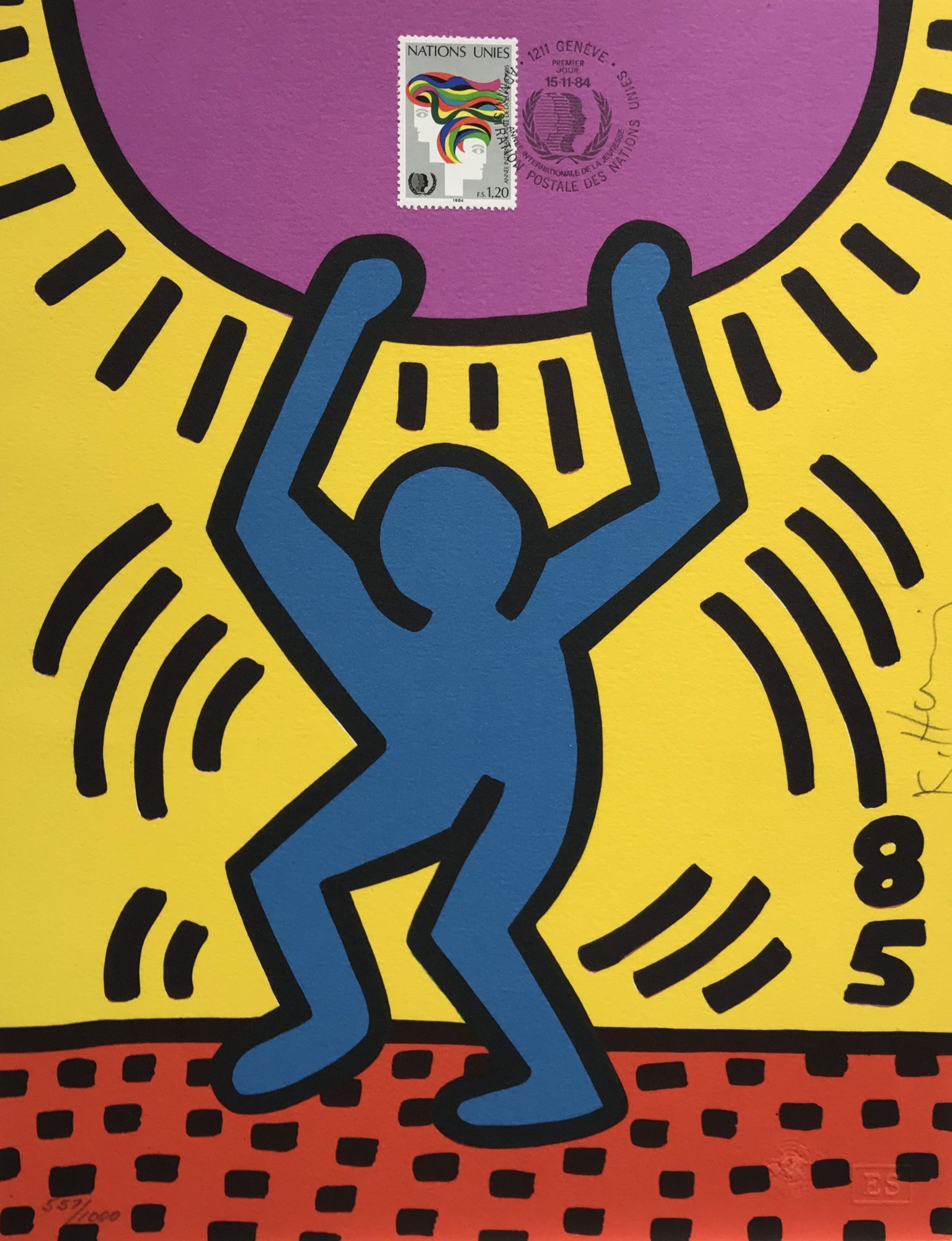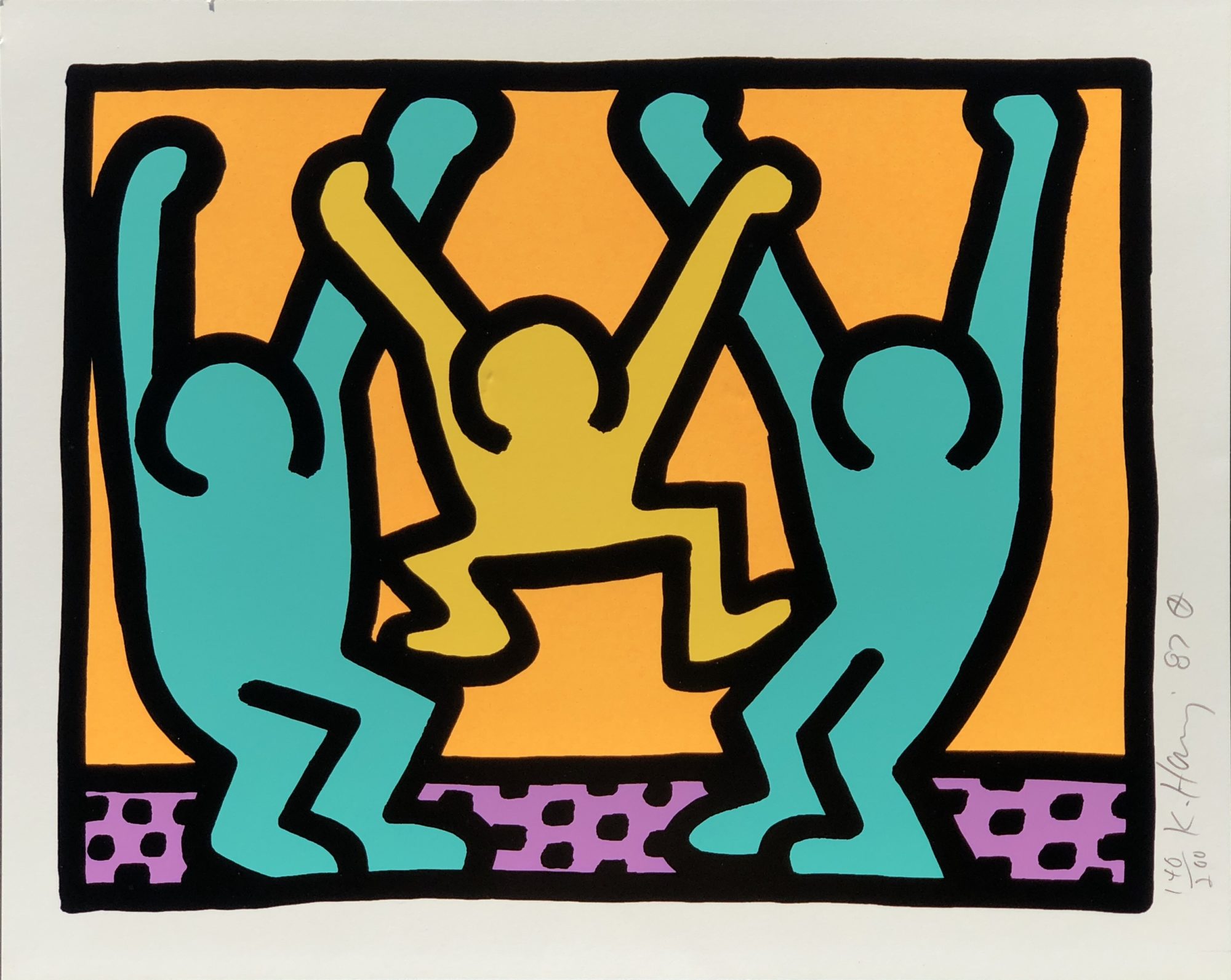Keith Haring – International Youth Year
Keith Haring, International Youth Year is an original lithograph from the edition of 1000. This print is signed and numbered. Keith Haring, International Youth Year was created in 1985 in celebration of this special year. A United Nations stamp was released the first of January the same year and one of these is attached to the print.
Bridging the gap between the art world and the street, Keith Haring rose to prominence in the early 1980s with his graffiti drawings made in the subways and on the sidewalks of New York City. Combining the appeal of cartoons with the raw energy of Art Brut artists like Jean DuBuffet, Haring developed a distinct pop-graffiti aesthetic centered on fluid, bold outlines against a dense, rhythmic overspread of imagery like that of babies, barking dogs, flying saucers, hearts, and Mickey Mouse. In his subway drawings and murals, Haring explored themes of exploitation, subjugation, drug abuse, and rising fears of nuclear holocaust, which became increasingly apocalyptic after his AIDS diagnosis. Alongside Jean-Michel Basquiat, Kenny Scharf, and Jenny Holzer, Haring is regarded as a leading figure in New York East Village Art scene in the 1970s and ’80s.
| Title | International Youth Year |
|---|---|
| Medium | Lithograph |
| Year | 1985 |
| Edition | 1000 |
| Signature | Signed, numbered |
| Size | 11 x 8.5 (in) 28 x 22 (cm) |
| Price | SOLD |
Description
Keith Haring, International Youth Year is an original lithograph from the edition of 1000. This print is signed and numbered. Keith Haring, International Youth Year was created in 1985 in celebration of this special year. A United Nations stamp was released the first of January the same year and one of these is attached to the print.
Bridging the gap between the art world and the street, Keith Haring rose to prominence in the early 1980s with his graffiti drawings made in the subways and on the sidewalks of New York City. Combining the appeal of cartoons with the raw energy of Art Brut artists like Jean DuBuffet, Haring developed a distinct pop-graffiti aesthetic centered on fluid, bold outlines against a dense, rhythmic overspread of imagery like that of babies, barking dogs, flying saucers, hearts, and Mickey Mouse. In his subway drawings and murals, Haring explored themes of exploitation, subjugation, drug abuse, and rising fears of nuclear holocaust, which became increasingly apocalyptic after his AIDS diagnosis. Alongside Jean-Michel Basquiat, Kenny Scharf, and Jenny Holzer, Haring is regarded as a leading figure in New York East Village Art scene in the 1970s and ’80s.
Keith Haring was born in Reading, Pennsylvania, on May 4, 1958. He was raised in Kutztown, Pennsylvania, by his mother Joan Haring, and father Allen Haring, an engineer and amateur cartoonist. His family attended the United Church of God. He became interested in art at a very early age spending time with his father producing creative drawings. His early influences included Walt Disney cartoons, Dr. Seuss, Charles Schulz, and the Looney Tunes characters in The Bugs Bunny Show.
After studying commercial art in Pittsburgh, Haring had a maintenance job at the Pittsburgh Center for the Arts and was able to explore the art of Jean Dubuffet, Jackson Pollock, and Mark Tobey. His most critical influences at this time were a 1977 retrospective of the work of Pierre Alechinsky and a lecture by the sculptor Christo in 1978. Alechinsky’s work, connected to the international Expressionist group CoBrA, gave him confidence to create larger paintings of calligraphic images. Christo introduced him to the possibilities of involving the public with his art. His first important one-man exhibition was in Pittsburgh at the Center for the Arts in 1978.
Keith Haring, International Youth Year
Additional information
| Title | International Youth Year |
|---|---|
| Medium | Lithograph |
| Year | 1985 |
| Edition | 1000 |
| Signature | Signed, numbered |
| Size | 11 x 8.5 (in) 28 x 22 (cm) |
| Price | SOLD |





